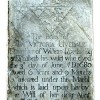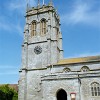It is interesting to note how widely those of Dorset origin destined to be famous will eventually travel in the course of their lives. But who would have thought that a girl from a Dorset family, born 90 years ago, would have risen to such a high position in society as to become our most famous prime minister’s daughter-in-law and, ultimately, nearly the most influential non-American ever in US politics? But this indeed was the remarkable destiny of Pamela Digby.
Pamela Beryl Digby was born on March 20th, 1920 into the aristocratic Digby family of Minterne House, Minterne Magna, above the Cerne valley in rural mid-Dorset, a manor which the family had held over many generations from about the mid-16th century onwards. Pamela was the eldest of the four children of Edward Kenelm Digby (the 11th Lord Digby, Earl of Minterne) and Lady Pamela Bruce, being therefore baptized in the name of her mother. Later, Minterne House would become the seat of her elder brother, who became the 12th Earl.
Pamela was educated through private tuition, and then at the instigation of her mother gained a qualification in domestic science. Following a year at a continental finishing school to round off her education, she settled in London for The Season of 1938, was presented at court, then landed a job as a translator (she spoke fluent French) with the Foreign Office. Her Dorset roots, however, may have lain behind the remark she is reported to have made to the high-society women of her inner circle in those early years: “I felt a real country bumpkin”.
But then in September 1939 on the outbreak of war, a phone call became the lynch-pin ratcheting Pamela up the society ladder several rungs at a time and changing her life forever. The caller was Winston Churchill’s son Randolph, then a 28-year-old army officer. Churchill had in fact intended to invite an absent friend of Pamela’s out to dinner, but Pamela instead took up Randolph’s invitation and went in her place. Mutual attraction must then have gone into overdrive that night, for just two weeks later the pair announced their engagement. Churchill Jr married Pamela on October 4th that year.
But from early on the marriage of the younger Churchills was in trouble. In the spring of 1940 Pamela’s father-in-law became Prime Minister and invited her to live in at 10 Downing Street, though it could be said that the reason was not entirely familial. By this time Pamela was pregnant and with the Blitz about to break upon London the move was probably more out of concern for the expectant mother’s safety. And it was here, taking refuge in the cellars of the PM’s London home that Pamela saw out the worst of the bombing in relative security. Her son Winston Jr, the future Conservative MP, was born at Chequers that October.
With the help of Lord Beaverbrook Pamela later secured a position at the Ministry of Supply. She was then 21 years old, but was already about to be swept up by the second of several romantic liaisons in her life. The man in question was Averill Harriman, a 49-year-old Special Liaison Officer to President Franklin Roosevelt, who had connections with the Ministry. Pamela’s affair with Harriman was a diversion from her unhappy marriage, though she did not divorce Randolph until 1947. This second affair initially lasted until December 1941, when Pearl Harbour propelled the US into the war and Harriman was recalled.
Once more becoming available, Pamela embarked upon another romantic tryst, this time with American broadcaster Ed Morrow, well known for his live roof-top reports from London when the Blitz was at its height. The Prime Minister, possibly keen to promote cordiality with the thousands of billeted American troops, is thought to have encouraged Pamela to conduct salons aimed principally at GI’s. At these salons Pamela entertained Generals Marshall and Eisenhower, as well as Anthony Eden, Hugh Gaitskell, and Edith Sitwell.
The war over, the divorced Mrs Digby Churchill and Winston Jr moved to Paris, where the salons became famous with anybody who was anybody in wealth, politics or letters. Pamela’s admirers included the Duke and Duchess of Windsor, the Rothchilds, Duff-Coopers, Cecil Beaton, Nancy Mitford, Frank Sinatra, Porfirio Rubirosa, Ali Khan, Stavros Niarchos, and Aristotle Onassis. Another client was Gianni Agnelli, heir to the Fiat fortune, with whom Pamela embarked upon an affair lasting five years. During this affair she converted to Catholicism, even adopting an Italian accent. After Agnelli, she took up with antiques connoisseur Elie de Rothchild, a romance that endowed her with expertise in antiques.
From 1955 onwards Pamela spent ever more time in the States. This led in 1960 to her second marriage, this time to theatre producer Leyland Hayward, a union that made her an authority on Broadway matters. She also took up her salons again, though this time mainly for a clientele in the arts. As Mrs Hayward, Pamela enjoyed ten years of considerably more wedded bliss than she had experienced with Randolph Churchill.
But in 1970 Hayward died. Four months later his widow was re-united with Averill Harriman, who by this time was 78 and now an available widower. With no war or upheaval to confound their marital plans the former wartime suitors were married in 1971. By this time the statesman had been in the service of every Democrat President since Roosevelt, had been Governor of New York, and had even stood as a presidential candidate himself. With Averill, Pamela travelled widely, visiting Andropov and Gorbachev in Moscow, and had acquired a great depth of knowledge about European affairs.
Harriman introduced Pamela to all the great Democrat stalwarts including Truman, Johnson and the Kennedys. Following personal involvement in the unsuccessful campaign for Muskie in 1972, Pamela then helped with Carter’s successful campaign in 1976. When Harriman’s health was failing in 1980 he is believed to have encouraged his wife to take on his political mantle, but by the time of his death in 1986 the Democrats were losing to Reagan and Bush.
With Harriman gone, Pamela established PAMPAC, a Political Action Committee to organize meetings and raise funds to elect a Democrat president. Pamela is also credited with introducing Bill Clinton to the Democratic establishment and supporting him in his campaign, just as she had backed Dukakis and Gore in 1988. It was even said that Pamela had become the most powerful woman in America after Hilary Clinton. Rumoured to have turned down an offer to be Ambassador to Britain, her knowledge of the country and its language made her the obvious choice for France’s Ambassador instead. So looking at least 20 years younger than her age, Pamela began her new consular career at the US embassy in Paris – still keeping up with her hosting!
Yet despite her youthful lust for life, Pamela Beryl Digby Churchill Hayward Harriman died in Paris on February 5th, 1997 aged 76. On the 13th she was flown back to America for burial in the National Cathedral, Washington. In her will she left her son Winston £6.2 million even though she did not approve of him leaving his own wife.
Today Minterne House is the centrepiece of extensive gardens with streams, lakes & waterfalls; parkland and 20 acres of woodland open to groups by appointment, a far cry from their quiet privacy when a girl called Pamela passed her childhood here 80 years ago.



